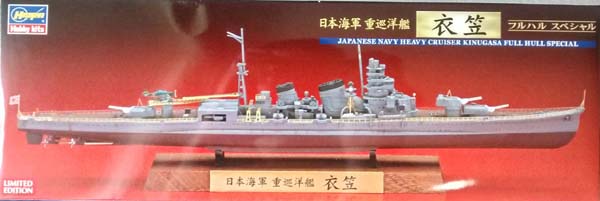Kinugasa and her sister ship Aoba were originally planned as the third
and fourth vessels in the Furutaka class of heavy cruisers. However, design
issues with the Furutakas resulted in modifications including twin turrets
and an aircraft catapult. These modifications created yet more weight to
an already top-heavy design, causing stability problems. Nevertheless,
Kinugasa played an important role in the opening stages of World War II.
In 1941, Kinugasa was assigned to Cruiser Division 6 (CruDiv6), as flagship
of Rear Admiral Aritomo Goto as part of the First Fleet under overall command
of Vice Admiral Takasu Shiro. CruDiv 6 consisted of Kinugasa, Aoba, Furutaka
and Kako. At the time of the attack on Pearl Harbor, CruDiv6 was engaged
in the invasion of Guam, following which it participated in the second
invasion of Wake Island.
From January–May 1942, Kinugasa was based out of Truk, in the Caroline
Islands where it provided protection for the landings of Japanese troops
in the Solomon Islands and New Guinea at Rabaul, Kavieng, Buka, Shortland,
Kieta, Manus Island, Admiralty Islands and Tulagi.
Kinugasa participated in the Battle of the Coral Sea as an escort to
the light aircraft carrier Sh?h?, which was sunk in the same battle. Furutaka
and Kinugasa, undamaged in the battle, escorted the damaged aircraft carrier
Sh?kaku back to Truk. On 14 July 1942, Kinugasa was assigned to the newly
created Eighth Fleet under Vice Admiral Mikawa Gunichi.
On 8 August 1942, north of Guadalcanal a three-seat Aichi E13A1 "Jake"
reconnaissance floatplane launched from Kako was shot down by an SBD Dauntless
of VS-72 from the aircraft carrier USS Wasp. This was the prelude to the
Battle of Savo Island the following day.
On 9 August, the four heavy cruisers of CruDiv 6 (Aoba, Kako, Furutaka
and Kinugasa), the heavy cruiser Ch?kai, light cruisers Tenry? and Y?bari
and destroyer Y?nagi engaged the Allied forces in a night gun and torpedo
action. At about 2300, Ch?kai, Furutaka and Kako all launched their reconnaissance
floatplanes. The circling floatplanes dropped flares illuminating the targets
and all the Japanese ships opened fire. The cruisers USS Astoria, Quincy,
Vincennes and HMAS Canberra were sunk. The cruiser USS Chicago was damaged
as were the destroyers Ralph Talbot and Patterson. Kako's gunfire hit Vincennes
in the hangar and destroyed all of her Curtiss SOC Seagull floatplanes.
On the Japanese side, Ch?kai was hit three times, Kinugasa twice, Aoba
once; Furutaka and Kako were not damaged.
At the Battle of Cape Esperance on 11 October 1942, CruDiv 6's (Aoba,
Furutaka and Kinugasa), and destroyers Fubuki and Hatsuyuki departed Shortland
to provide cover for a troop reinforcement convoy by shelling Henderson
Field on Guadalcanal. The fleet was spotted, coming down "the Slot" at
30 kn (56 km/h; 35 mph), by two Vought OS2U Kingfisher reconnaissance floatplanes.
So alerted, the radar-equipped American cruisers USS San Francisco, Boise,
Salt Lake City, and Helena and five destroyers steamed around the end of
Guadalcanal to block the entrance to Savo Sound.
At 22:35, Helena's radar spotted the Japanese fleet, and the Americans
successfully crossed the Japanese "T". Both fleets opened fire, but Admiral
Goto, thinking that he was under friendly fire, ordered a 180-degree turn
that exposed each of his ships to the American broadsides. Kinugasa straddled
Boise and Salt Lake City with 8-inch salvos, knocking out Boise's No. 1
and 2 turrets. Kinugasa sustained four hits in the engagement. The following
morning, Kinugasa was attacked but not damaged by five American planes,
and then returned to Shortland.
On 14 October 1942, Kinugasa was designated flagship of Crudiv 6. The
following day, Kinugasa and Ch?kai bombarded Henderson Field on Guadalcanal
with a total of 752 8-inch shells.
From 24–26 October and 1–5 November, Kinugasa and Ch?kai provided cover
for replacement convoys of troops and equipment to bolster Japanese defenses
at Guadalcanal. On 14 November, during the Naval Battle of Guadalcanal,
Kinugasa was attacked by Grumman TBF Avenger torpedo bombers and Douglas
SBD Dauntlesses from USS Enterprise and USMC Avengers from Guadalcanal.
At 09:36, a 500-pound bomb hit Kinugasa's 13.2 mm (0.5 in) machine gun
mount in front of the bridge, starting a fire in the forward gasoline storage
area. Captain Sawa and his Executive Officer were killed by the bomb, and
Kinugasa gradually began to list to port. Near-misses caused additional
fires and flooding and a second attack by 17 more Dauntlesses knocked out
Kinugasa's engines and rudder and opened more compartments to the sea.
At 11:22, she capsized and sank southwest of Rendova Island at 08°45?S
157°00?ECoordinates: 08°45?S 157°00?E, taking 511 crewmen with
her.
Kinugasa was removed from the Navy list on 15 December 1942.
|




